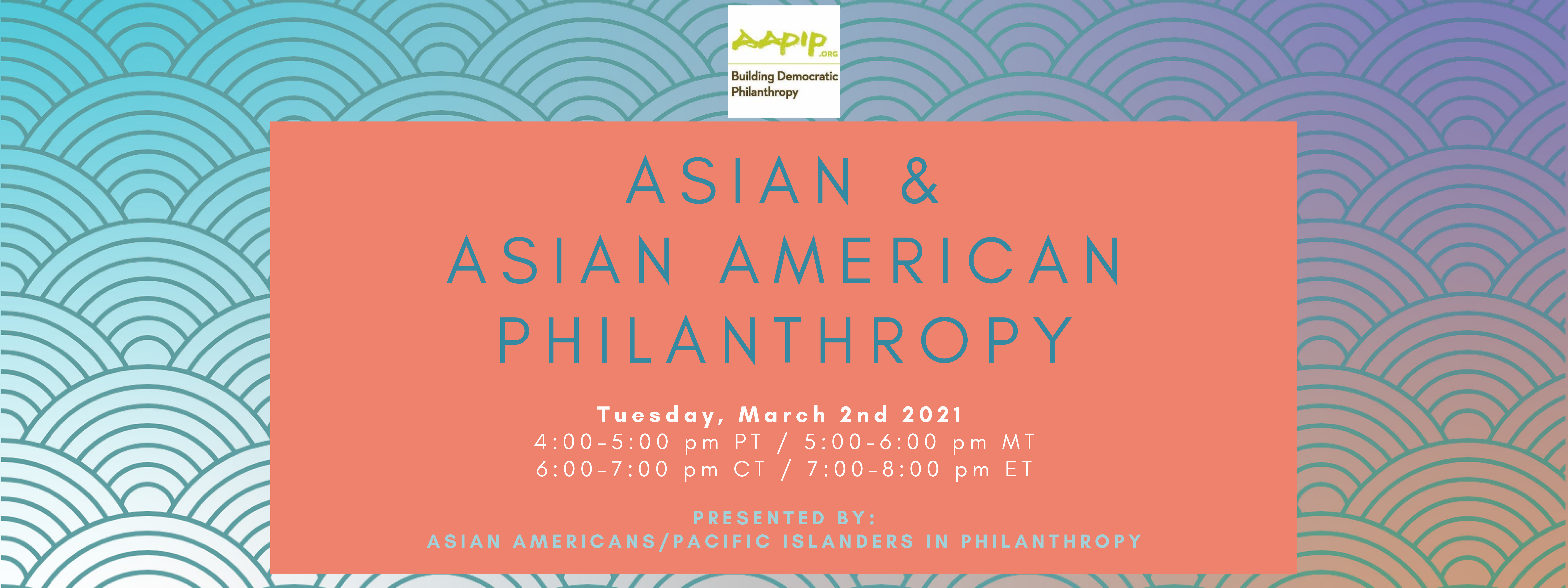By Vivian Gee, Lijun He, Anjana Sundaram
On March 2nd, 2021, Asian American Pacific Islanders in Philanthropy (AAPIP) hosted a webinar exploring the philanthropic motivations and approaches in the practice of philanthropy among a panel of Asian and Asian American philanthropists (i.e. high net worth individuals and private family foundations). You can view the full recording here.
Our panelists included:
- Richard Woo, Former CEO of Russell Family Foundation (moderator)
- Yumiko Damashek, Former Corporate Executive and Board Member of Refugee Artisan Initiative
- Michael Jiang, Former WeWork China CEO and Founder of Matchbox Foundation
- Srilakshmi Remala, Remala Family Foundation and Program Officer at Gates Foundation
Seven key themes emerged from their dynamic conversation.
1. AAPI philanthropy has gone through significant shifts in the past three decades, with a growing curiosity for supporting systems change and racial equity.
Richard Woo noted the motivations for giving have slowly shifted away from traditional wealth preservation and legacy planning, with intergenerational giving focused more on measurable impact and longer-term systems change.
2. Wealth creation and social impact are becoming more integrated, with some philanthropists applying a business and strategic lens to their personal giving, e.g. venture philanthropy, impact investing, social entrepreneurship.
Yumiko Damashek shared that she combines her roles as an activist, a strategist, and a philanthropist; her approach to philanthropy combines strategy development, ecosystem building, and financial support to help drive impact. Michael Jiang added that he hopes to bring a business approach to the Matchbox Foundation, the organization he co-founded in 2017, in both operations and developing products with clear goals drawing from his extensive commercial industry experience.
3. Motivations and areas of giving are often driven by values and shaped by personal and/or family experiences, especially among AAPIs with transnational and immigrant experiences.
All our panelists shared moving accounts of their motivations that drive their philanthropy. As an example, Michael Jiang shared that he grew up in a small village in Northern China and credits a teacher with inspiring his world view. He now hopes to help increase access to high quality primary education in rural areas of China through the Matchbox Foundation. Similarly, Srilakshmi Remala mentioned the multigenerational origins of her family foundation, the Remala Family Foundation, which was started 20 years ago with the motivation that education was a pathway to opportunity, alongside access to high-quality healthcare.
4. Economic and political systems, social safety nets, and tax policies shape how philanthropy is practiced in different countries.
Michael Jiang, Yumiko Damashek, and Richard Woo mentioned there are unique regulatory environments to consider internationally that differ from US-based philanthropy. They noted the larger role that the government plays internationally in providing a social safety net.
5. Philanthropists can play a role in activism and movement building by supporting community-based organizations and backbone/intermediary organizations.
As an example, Srilakshmi Remala mentioned her family foundation invests in Asia but also has an increasing presence investing in organizations supporting local community organizations in the Pacific Northwest using a data-driven approach.
6. AAPI philanthropists can build stronger relationships with the underserved communities by giving locally, practicing trust-based philanthropy, and building the capacity of grassroots organizations.
Srilakshmi Remala emphasized the importance of seeing the work done locally and nurturing relationships with community leaders to build trust and stronger partnerships. Yumiko Damashek added that accurate data on community needs is crucial for philanthropists to effectively fund community organizations. Michael Jiang also mentioned that thinking through the sustainability of the partner relationship upfront is very important to ensure there is a full lifecycle value for the community in maintaining services to the underserved.
7. AAPIs can and should contribute to and drive the conversation on racial equity. AAPIs have insights into servicing communities in a culturally relevant way, disaggregating data to better understand needs, and standing in solidarity with communities hurting the most, even when it’s not the communities they immediately represent.
Panelists noted that with the combination of the pandemic and the racial reckoning happening in the United States has allowed many people to engage deeper in racial equity issues. Their advice was for Asian Americans and Pacific Islanders to keep up the activism to advocate for underserved communities and stand together in solidarity.
—
Please refrain from contacting the panelists in this webinar to respect their privacy.
—
Follow AAPIP to be notified about future webinars, research reports, and other engaging programming that spotlights the emerging needs of AAPI communities and AAPI philanthropy.

